◆Decipher Castle-Making Concept◆
At first I began to walk around the moats from the northwest entrance of the park to the south entrance, againt the clock-hand rotation.
Thereafter from the same start-point, walking through Ninomaru Park to Taiko-mon, I got out to Marunouchi Street and went northward along the Ninomaru-Bori moat over Fukashi Bridge to Soto -bori.
The avenue between the castle and Ootemon was a part of San-no-maru, i.e. the third site, the outside of which was surounded by a moat named Soto-bori, i.e. the outer moat.
The road running from east to west between Kaichi 1 Chome and Mastumoto Shrine was a bank line of the moat. At its crossroads was lying Maru-umadashi, i.e. a arc-shaped banker.
Now We find a wooden red bridge named Tanuki-bashi, which would reaches Honmaru, over a wide moat. As the moat here is the widest, the main tower-complex looks like a castle floating on the lake.
Walking along the moat, we pass by Kuro-mon, the black gate, and reach the south-entrance of the park. The oblong section (with longer side of 300 meters) from here to north was once a part of the moat named Ninomaru-bori.
The section has been a residential town but now the city autority plans to restore the moat.
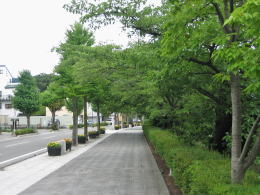
▲Side walk on north side of castle-park
The part of the prefectural road 67 was San-no-maru, the third site of the castle, in Edo period. Sotobori, the outer moat guarded on the north side of it. Two bridges, at the end of them the bankworks called Umadashi were lying, were crossing over the moat.
Umadshi(mouse on here)
Then, let's go back to the starting point and walk along the moats in adverse.
The earthwork of Honmaru, the core site, are covered thoroughly with stone-walls. But that of Ninomaru, the second site, are half-covered. Only the parts touching water are covered with stone-walls.
Such a earthwork style is called Hachimaki-doi, i.e. a bankwork of the head-band cover. Hachimaki means a head-band and Doi means a earthwork.
Comparing the earthworks of the both sites, we notice the rather big difference of their height. Honmaru earthwork is much higher than other sites. That means the difference of their deffencibility and military importance.
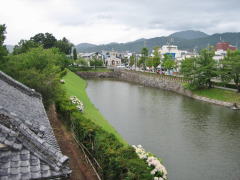
▲View of moat from Taiko turret
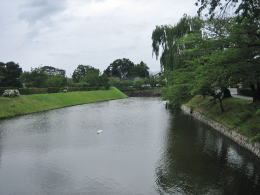
▲View westward
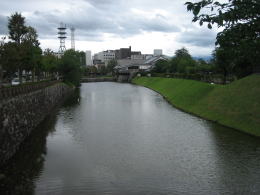
▲View eastward
Walking over a small bridge, called Ninomaru-ura Gomon-bashi, over the moat, we get into Ninomaru and through it we arrived at Taikomon. There was once a huge palace, called Ninomaru-Goten there. Just after administrative reforms in the first phase of Meiji period it was used for a prefectural hall. But was burned out before long.
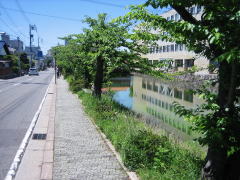
The pool is a vestige of the outer moat.
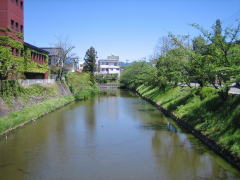
It is now a shallow pond.
Going on Marunouchi street east, we get to Fukashibashi bridge. The pools beneath it is the vestiges of the outer moat, called Sobori. |
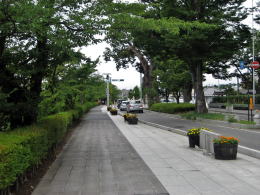
Street between Castle and shrine
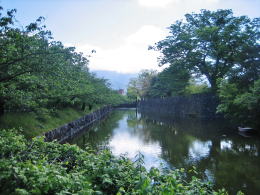
View of moat from northeast gate
|
